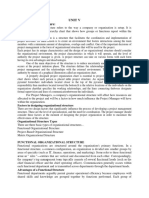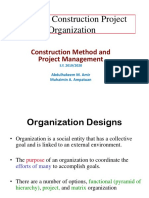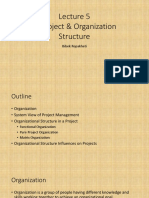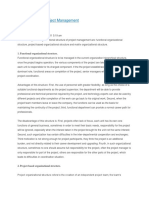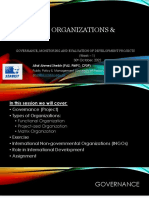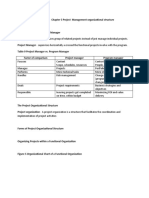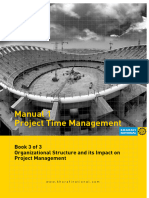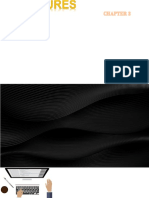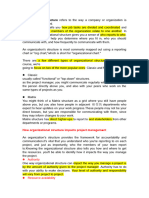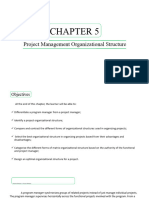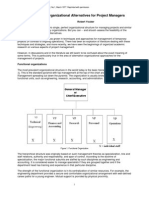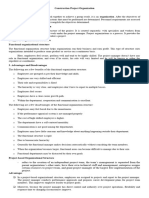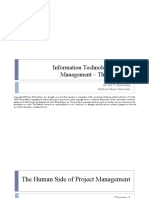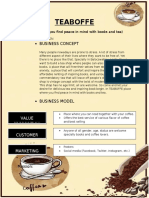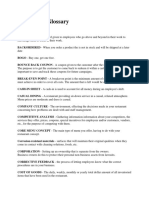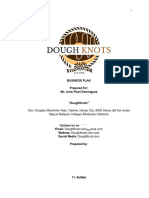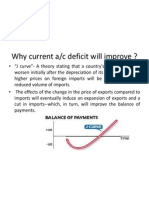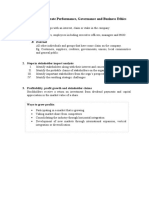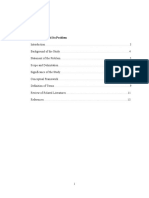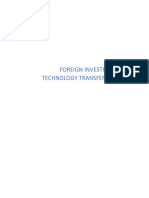Project Management Structures
Uploaded by
Tanmay shitoleProject Management Structures
Uploaded by
Tanmay shitoleAISSMS IOIT TE(E&TC)
Index
3.1 Introduction
3.2 Concept of Organizational Structure
Unit 3: Project Organizational structure & Issues
3.3 Roles and Responsibilities of Project Leader
3.4 Relationship between Project Manager and Line Manager
3.5 Leadership Styles for Project Managers
3.6 Conflict Resolution
3.7 Team Management and Diversity Management
3.8 Change management
Project Management Milind P Gajare
AISSMS IOIT TE(E&TC)
3.1 Introduction
A project organization is a structure that facilitates the coordination and implementation of
project activities. Its main reason is to create an environment that fosters interactions among
the team members with a minimum amount of disruptions, overlaps and conflict. One of the
important decisions of project management is the form of organizational structure that will be
used for the project.
Each project has its unique characteristics and the design of an organizational structure should
consider the organizational environment, the project characteristics in which it will operate,
and
the level of authority the project manager is given. A project structure can take on various
forms with each form having its own advantages and disadvantages.
One of the main objectives of the structure is to reduce uncertainty and confusion that typically
occurs at the project initiation phase. The structure defines the relationships among members
of the project management and the relationships with the external environment. The structure
defines the authority by means of a graphical illustration called an organization chart.
A properly designed project organization chart is essential to project success. An organization
chart shows where each person is placed in the project structure. An organization chart is drawn
in pyramid form where individuals located closer to the top of the pyramid have more authority
and responsibility than members located toward the bottom. It is the relative locations of the
individuals on the organization chart that specifies the working relationships, and the lines
connecting the boxes designate formal supervision and lines of communication between the
individuals.
Project Management Milind P Gajare
AISSMS IOIT TE(E&TC)
Fig, Project Organization Chart
3.2 Concept of Organizational Structure
Organizational structure refers to the way a company or organization is set up. It is usually
defined using a hierarchy chart that shows how groups or functions report within the
organization.
For Project Managers, a company's organizational structure type will affect how resources are
allocated to the project and will be a factor in how much influence the Project Manager will
have within the organization.
Types of Organizational Structures:
An organizational structure could be described as the official line of authority and control
within an organization. Project management structures tell us how reporting relationships work
in a particular organization.
Depending on the environment the organization finds itself operating in, the goals they set for
themselves and the nature of work being done, you would find that organizations are structured
in 3 ways:
1)Functional Organizational Structure
In a functional organizational structure, you would find the components of a hierarchy system
where authority-driven decisions on budget, schedule, and equipment rest on the shoulders of
Project Management Milind P Gajare
AISSMS IOIT TE(E&TC)
the functional manager who possesses a significant level of expertise in the same field. That is
to say that the project manager, in this type of organization has little to no authority here; in
some functional organizations, that position does not even exist.
What would you find, however, is that the work is broken down into departments such as the
human resource department, sales department, finance, public relations, administration, etc.
In simple terms, it can be likened to that of a more traditional company where staff is presided
over by a supervisor, based on their functions within the organization and communication is
most often done through the department heads to senior management.
What is fascinating about this type of organizational structure is that employees appear to be
more skilled in their respective departments, thereby leading to greater work efficiency.
Everyone knows who to hold accountable if something were to go wrong as responsibilities
are predetermined.
On the downside, the work may prove monotonous over time, which could result in less
enthusiasm and reduced loyalty to the organization. In addition to that, you would also find
that cross-departmental communication becomes poor and the high level of bureaucracy could
affect decision-making negatively.
Examples of functions within a company are:
Advertising
Engineering
Human Resources
Project Management Milind P Gajare
AISSMS IOIT TE(E&TC)
Manufacturing
In a functional organization, every employee is positioned within only one function and has
one manager they report to, the Functional Manager. The Functional Manager assigns and
manages the employee’s work and handles administrative tasks such as employee
compensation.
2. Project-Based Organizational Structure
The projectized organizational structure is the complete opposite of the functional
organizational structure even though the organization may still group staff according to their
work functions.
In this case, the project management team structure is organized in such a way that the project
manager has project authority. He has jurisdiction over the project’s budget, schedule, and the
project team. You would find him at the top of the hierarchical structure, calling all the shots;
with employees playing supporting roles for the project. At the end of the project, the project
team members are released and resources directed towards more relevant areas.
What’s great about this kind of structure is that there is a clear, established line of authority;
resulting in faster decision-making and approval. Communication becomes easier and more
effective and project team members gain more experience working on different types of
projects as the need for them arises.
A major disadvantage to this type of organizational structure, however, would be that
employees could see themselves being under a lot of pressure most of the time, especially if
they happen to work on multiple projects at the same time. This often leads to poor
communication amongst the team members as everyone is left more or less playing “catch-up”.
Project Management Milind P Gajare
AISSMS IOIT TE(E&TC)
3. Matrix Organizational Structure
Matrix organizations blend features of project-based and functional organizational structures.
The key challenge with a matrix organization is that every employee has two (or more)
managers they report to, their Functional Manager and the Project Manager. If they are working
on multiple projects, they may have even more managers to report to.
There are three types of matrix organizations:
• Weak Matrix
• Balanced Matrix
• Strong Matrix
The matrix organizational structure can be found lying somewhere between the functional
organizational structure and the projectized organizational structure depending on what type of
matrix structure is being run.
For instance, the strong matrix organizational structure has some similarities with that of a
projectized organizational structure in the sense that the project manager is responsible for a
project. If the organization is running a weak matrix structure, then the project authority would
fall to the hands of a functional manager – as it is in a functional organization. Interestingly
enough, in a balanced matrix organization, both the project manager and the functional
manager shares equal authority for the project.
Project Management Milind P Gajare
AISSMS IOIT TE(E&TC)
If an organization finds itself working in a dynamic environment, then this might be the right
structure to run with it and it promotes greater efficiency, helping the organization respond to
customer demands or changes in the marketplace, faster.
This is easily achieved because while the project manager exhibits project authority in a
horizontal manner, the functional manager does so in a vertical, flowing downwards. For
example, the project manager could be responsible for handling project schedule or budget
while the functional manager would be responsible for outlining and distributing
responsibilities, overseeing the performance of the equipment, etc.
Weak Matrix:
A weak matrix organizational structure maintains many of the features of the functional
organizational structure. The role of the Project Manager is more that of a Project Coordinator.
Their ability to make or enforce decisions is low and most of the authority remains with the
Functional Manager.
Project Management Milind P Gajare
AISSMS IOIT TE(E&TC)
Balance Matrix:
A balanced matrix organizational structure recognizes the need for a Project Manager.
However, the Project Manager does not have full authority over the project, project staff or
project budget.
Strong Matrix:
A strong matrix organizational structure has many of the features of the projectized
organizational structure. They have full-time Project Managers and project administrative staff.
Project Managers have considerable authority over the project in this organizational structure.
Project Management Milind P Gajare
AISSMS IOIT TE(E&TC)
3.3 Roles and Responsibilities of Project Leader
Project Leader:
A project leader is a professional who leads people and makes sure a project is carried through.
The project leader engages the team, motivating them, taking care of their needs and
maintaining a friendly and productive work environment.
Project Leader Roles & Responsibilities:
A project leader’s responsibilities will vary based on the company, industry, and even project
management role structure. Here are some common responsibilities:
• Work with departmental heads, managers, and other stakeholders to develop team goals and
delegate tasks to the appropriate team member
• Develop team schedules and assist in the successful onboarding and training of team
members
• Create and communicate a clear list of expectations and goals for team members to follow
• Offer emotional support to project team members and make people feel valued
• Maintain frequent communication to offer encouragement, amend tasks, and provide
updates on goal progress
• Implement incentives to keep the team motivated and focused on their daily tasks project
goals
• Provide frequent feedback on employee performance, address weaknesses or inefficiencies,
and offer support to improve skill gaps
• Nurture collaboration amongst team members
• Create a workspace that encourages creativity and innovation to get the most out of the team
• Quickly and effectively resolve team conflicts
• Write project reports as necessary
• Reward team members for their continued efforts and celebrate accomplishments
Project Management Milind P Gajare
AISSMS IOIT TE(E&TC)
Project Leader Skills
A project leader has a unique set of skills that provide the tools needed to lead their team
successfully. Required hard skills will be specific to the industry and may include project
management platforms, industry knowledge, or relevant licensing.
There are, however, a number of soft skills that help with a project leader’s responsibilities,
including the following:
a) Team Management
The bulk of a project leader’s responsibilities rely on effectively managing their team. To
achieve project goals, leaders must establish a team of individuals with the right skill sets and
encourage collaboration. Successful team management involves teamwork, goal setting, and
regular performance reviews.
b) Communication
Strong communication is an essential project leader skill. To effectively convey ideas, or direct
a team of employees, leaders should promote and facilitate communication.
c) Listening
Project leaders should be focused on actively listening to their team. Understand team
members’ concerns and feedback and work to rectify any issues to avoid disruptions to
productivity.
d) Conflict Resolution
When a diverse group of individuals work within close proximity, conflict is often inevitable.
However, nothing quite hinders productivity than team friction. Project leaders must swiftly
recognize emerging conflicts and work to de-escalate any tension or disputes among team
members. A work environment should be harmonious for all team members to thrive.
e) Team Leadership
The position title of project leader is one major indicator that leadership is the most critical
skill required for success in the role. Project leaders must work without biases to ensure all
team members are treated equally. Leadership requires a combination of conflict resolution,
Project Management Milind P Gajare
AISSMS IOIT TE(E&TC)
team management, and communication. Set goals that are in line with project requirements and
provide the team with the necessary tools to achieve them.
f) Organization
Strong organizational skills are crucial to creating and keeping deadlines, delegating tasks, and
making effective schedules for their team.
g) Critical Thinking
Finding creative solutions, anticipating potential roadblocks in productivity, and overcoming
obstacles are typical challenges faced by project leaders. A good project leader possesses strong
critical thinking skills that empower them to achieve success no matter the situation.
h) Time Management
Although primarily focused on leading their teams, there are still deadlines that project leaders
must ensure are met. These professionals must understand the capabilities and skill levels of
the team and strong time management skills to ensure all tasks are completed efficiently.
3.4 Relationship between Project Manager and Line Manager
Project Manager:
A project manager is the person responsible for leading a project from its inception to
execution. This includes planning, execution and managing the people, resources and scope of
the project. Project managers must have the discipline to create clear and attainable objectives
and to see them through to successful completion. The project manager has full responsibility
and authority to complete the assigned project.
Line Manager:
A line manager is the first layer of management above the front-line workers. They're
accountable for their department, or part in the business. They manage one or more members
of staff and oversee and evaluate employee contribution, performance and development. Line
managers are the first point of contact for their direct reports, and they liaise and relay
information between senior leaders, HR and workers.
Project Management Milind P Gajare
AISSMS IOIT TE(E&TC)
Project manager and line manager interface refers to working relationship between the project
manager and line manager to get project activities accomplished within the constraint of
limited time, allocated cost, and specified quality performance.
A project manager is fully responsible to achieve the project objectives within the parameters
(constraints) of time, cost, and quality standards.
The project manager needs all types of human and non-human resources like money,
manpower, materials, equipment, information, and technology, etc. for the successful
completion of a project through the smooth operation of project activities. But project manager
does not control the resources directly accepted the project budget. The resources are collected
by line managers, they are often called as a resource manager. They assign directly to resources
to projects. Project managers control only those resources which are temporarily loaned by line
managers. S/he reminds the line managers that there is also time and cost constraints of the
project. This is the starting point for better resource control. Therefore project manager must
negotiate with all line mangers for pooling require resources on time.
Project manager always required to interface with the line managers for the following major
purposes.
• To get needed resources from the functional department on time.
• To get the good support of line managers while negotiating with various parties in
connection with project work.
• To achieve harmonization between project works and line department's work.
• To get technical and managerial assistance.
• To solve the project-related problems.
The effective project management and project success is highly dependent on working
relationship between project manager and line manger. So there must be better coordination,
reporting, communication and negotiation between them for good working relationship.
Moreover to promote good working relationship, project manager should help a proper
understanding of:
• Quantitative tools and techniques for planning, scheduling and controlling work.
• Organization structure, own job description.
• Open communication with line managers including effective coordination.
• Organizational behavior to tackle the problems of dual reporting system.
Project Management Milind P Gajare
AISSMS IOIT TE(E&TC)
3.5 Leadership Styles for Project Managers
1) Laissez-Faire
In a French phrase, laissez-faire can be interpreted as “hands-off”. This project manager’s
leadership style tends to just let their team lead themselves. Teams are left to make decisions,
set goals, and implement their own ideas in completing the assigned tasks.
The Laissez-Faire leadership style is usually based on the value of trust. On the one hand, this
style will be very good and suitable to be applied to organizations that require innovation and
creativity, for example, agencies and start-ups. However, this leadership style can also have a
negative impact and reduce the chances of project success if the team is not fully mature. In this
situation, the team may feel the project manager’s lack of interaction and responsibility.
2)Transactional
“You throw a stone at my back, then I will do the same” at least this is a phrase that describes
this one leadership style. This style focuses on goals, feedback, and ways to determine the
rewards a person gets.
A project manager with a transactional style will usually be rigid in implementing rules,
processes, and procedures. They will even implement something called reward and punishment
so that the team is always disciplined in implementing the values it has created.
On the positive side, the style that was first termed by Max Weber in 1947 can be effective
motivating teams to work on short-term projects. However, this style is not very suitable when
faced with sustainable or long-term projects. Therefore, this style is generally used at the
middle management level.
3)Servant
Do you prioritize team interests over personal interests? Then you may belong to a group with
a servant leadership style. A project manager with this style usually has traits such as: focus on
others, growth, learning, shared prosperity, relationship orientation, and team collaboration.
Popularized by Robert K. Greenleaf in 1970, the servant leadership style usually prioritizes
meeting the needs of the team at work.
Project Management Milind P Gajare
AISSMS IOIT TE(E&TC)
Because it is strong in personal relationships, this style can create a strong relationship between
the project manager or leader and his team or subordinates. One of the servant leadership styles
will be applied in government institutions.
4) Transformational
The next project manager leadership style is transformational. This leadership style has
characteristics such as: empowering the team through ideal attributes and behaviors, inspirational
motivation, encouraging innovation and creativity, and individual consideration. Of the many
characteristics above, the main characteristic of the transformational leadership style is
inspiration.
Project managers with this style tend to inspire teams with a shared vision and mission about
future goals. Similar to but different from the charismatic style, the transformational style
provides inspiration through the main vision and mission of the organization, not on aspects of
its personality. In a leadership environment like this, the team will usually be very proactive,
enthusiastic, innovative, and highly committed, so close supervision is not required.
5) Charismatic
The main magnetic force in the charismatic leadership style is in the personality or charm of
the leader, or in this case the project manager. The main characteristics of a leader with a
charismatic style include high energy, enthusiasm, strong belief, and self-confidence. These
personality traits then carry persuasive power to the team or its followers.
Charismatic leadership style can be seen in religious figures, activists, figures, to political
figures, but also does not rule out the possibility to be seen in the business sphere. While it may
sound like personal power, a project with a leadership style can be very risky. If the team
focuses too much on the charismatic leader, the project may be disrupted if there is a change
of leader.
However, the charismatic leadership style can be very effective when combined with style
choices such as democratic, consensus, and coaching or empowerment.
6) Interactional
The leadership style of this project manager can be said to be a combination of transactional,
transformational, and charismatic. Project managers with an interactional style consider
Project Management Milind P Gajare
AISSMS IOIT TE(E&TC)
variables such as the work environment, corporate culture, market challenges, conflict and
complexity, and the influence of leaders on the business.
They then use considering that their influence will have maximum impact if used when
individuals interact with certain situations.
There are two models of interaction carried out by project managers with this style, namely
relationship-oriented (based on relationships) and task-oriented (based on tasks).
3.6 Conflict Resolution
Conflict is unavoidable in a project environment. A conflict is a struggle and a clash of interest,
opinion, or even principles. Bring together a group of people to work on a project or in the
workplace and there is bound to be conflict at some point. Everyone has a different need, goal,
attitude, or outlook which doesn’t always agree with someone else’s. A key skill of any project
or team manager is conflict resolution in the workplace.
It’s important that any conflict that arises is dealt with quickly and professionally to avoid the
issues affecting morale and productivity and ensure there isn’t any delay to a project’s
completion. Everybody deals with conflict in a different way and how the project manager
deals with it can impact the whole team.
Sources of conflict include
• uncommon resources
• scheduling priorities
• personal work styles
Team ground rules, group norms, and solid project management practices, like communication
planning and role definition, reduce the amount of conflict. Successful conflict management
results in greater productivity and positive working relationships. When managed properly,
differences of opinion can lead to increased creativity and better decision-making. If the
differences become a negative factor, project team members are initially responsible for their
resolution. If conflict escalates, the project manager should help facilitate a satisfactory
resolution. Conflict should be addressed early and usually in private, using a direct,
collaborative approach. If disruptive conflict continues, formal procedures may be used,
including disciplinary actions. The success of project managers in managing their project teams
Project Management Milind P Gajare
AISSMS IOIT TE(E&TC)
often depends on their ability to resolve conflict. Different project managers may use different
conflict resolution methods.
Factors that influence conflict resolution methods include:
• Importance and intensity of the conflict,
• Time pressure for resolving the conflict,
• Relative power of the people involved in the conflict,
• Importance of maintaining a good relationship, and
• Motivation to resolve conflict on a long-term or short-term basis.
There are five general techniques for resolving conflict. Each technique has its place and use:
Withdraw/avoid: Retreating from an actual or potential conflict situation; postponing the
issue to be better prepared or to be resolved by others.
Smooth/accommodate: Emphasizing areas of agreement rather than areas of difference;
conceding one's position to the needs of others to maintain harmony and relationships.
Compromise/reconcile: Searching for solutions that bring some degree of satisfaction to all
parties in order to temporarily or partially resolve the conflict. This approach occasionally
results in a lose-lose situation.
Force/direct: Pushing one's viewpoint at the expense of others; offering only win-lose
solutions, usually enforced through a power position to resolve an emergency. This approach
often results to a win-lose situation.
Collaborate/problem solve. Incorporating multiple viewpoints and insights from differing
perspectives; requires a cooperative attitude and open dialogue that typically leads to consensus
and commitment. This approach can result in a win-win situation.
3.7 Team Management and Diversity Management
Team Management:
Team management includes the processes required to make the most effective use of the people
involved with the project. The project team includes the project manager and the project staff
who have been assigned the responsibility to work on the project. Managing a project team is
quite different than managing other types of staff, the project team has a start and an end, in
terms of duties assigned to the project. Team members come to the project with different skills
and experiences, and in many cases, it is the first time that they are working together. Due to
the high level of uncertainty, roles, and responsibilities, changes occur more frequently, and
Project Management Milind P Gajare
AISSMS IOIT TE(E&TC)
the team needs to be flexible enough to adapt to new challenges. Due to time constraints, there
is more stress working on a project caused by the inherent uncertainty of working in new areas
or with new groups of stakeholders, or in solutions that no one has ever explored before.
As the project starts, the team is unclear about their roles and the strategic direction of the
projects, some new hires need to adapt to a new organization and its ways of doing things, in
addition to understanding its mission, vision, and values. All of these circumstances increase
the level of frustration typical at the start of any new project. Lack of availability of key
personnel may increase the workload on the rest of the team members who are being asked to
do more than what was originally planned. Team management is not only limited to hiring and
reassigning staff after the end of the project, it involves careful planning to ensure that the
project has the right people at the right time doing the right things. Despite the recent
information and technology revolution in project management, people are still at the center of
project management and they determine the success or failure of a project. The project team is
involved in the definition of the project goals, which are instrumental in planning, organizing,
directing, coordinating, and monitoring all project activities. The team is able to meet the
project goals and objectives by the skillful use of interpersonal and organizational skills such
as communication, delegation, decision-making, and negotiation. In the challenging
environment of development projects, people can be viewed either as problems and constraints
or as solutions and opportunities.
Team Management Process:
Project Management Milind P Gajare
AISSMS IOIT TE(E&TC)
The major processes involved in team management are:
Plan: Team identification, the process of identifying the skills and competencies required
for carrying out the project activities and assign roles and responsibilities.
Do: Team building, organizing the team and building their capacity to perform on the
project, provide coaching and mentoring.
Check: Evaluate team and individual performance, monitor skills, and motivation.
Adapt: Improve team performance, build skills and set new targets
Inputs: Inputs for the project team management include the following documents or sources
of information:
• WBS
• Project Scope Statement
• HR organization policies
• Assessment of team skills
• Performance reviews
Outputs: The project team will use the above information to develop four important documents
for the project:
• Staffing management plan
• Resource responsibility matrix
• Team evaluations
• Development plans
Diversity Management:
Diversity management refers to organizational efforts that try to promote the good inclusion of
individuals from various backgrounds into an organization's structure through specialized
policies and initiatives. As a result of the increased variety of the workforce around the world,
businesses are implementing diversity management techniques.
Companies may now recruit and manage staff from all over the world and in multiple time
zones. Companies are developing particular policies and programs to improve employee
participation, promotion, and retention of employees from all origins and cultures. The
Project Management Milind P Gajare
AISSMS IOIT TE(E&TC)
programs and policies are intended to create a friendly atmosphere for groups that have
previously been denied access to employment and higher-paying occupations.
In the mid-1980s, North America pioneered the concept of variety, which later extended to
other regions of the globe. Ronald Reagan, the then President of the United States, had
promised to repeal the anti-discrimination and affirmative action legislation. Employees from
Equality and Affirmative Action presented the case that diversity management should be
viewed as a competitive advantage for US businesses rather than a regulatory requirement.
The discussion generated interest in the concept of diversity and the advantages of diversity
management. With the globalization of the world economy and the expansion of multinational
organizations, diversity management has taken on a new meaning, referring not only to the
heterogeneity of the workforce in one country but also to the composition of the workforce
across countries.
Types of Diversity Management
The following are the two types of diversity management:
1. Intranational diversity management
Intranational diversity management refers to managing a workforce that comprises citizens or
immigrants in a single national context. Diversity programs focus on providing employment
opportunities to minority groups or recent immigrants.
For example, a French company may implement policies and programs with the aim of
improving sensitivity and providing employment to minority ethnic groups in the country.
2. Cross-national diversity management
Cross-national, or international, diversity management refers to managing a workforce that
comprises citizens from different countries. It may also involve immigrants from different
countries who are seeking employment.
An example is a US-based company with branches in Canada, Korea, and China. The company
will establish diversity programs and policies that apply in its US headquarters, as well as in
its overseas offices.
Project Management Milind P Gajare
AISSMS IOIT TE(E&TC)
The main challenge of cross-national diversity management is that the parent company must
consider the legislative and cultural laws in the host countries it operates in, depending on
where the employees live.
Characteristics of Diversity Management
1. Voluntary
Unlike legislation that is implemented through sanctions, diversity management is a voluntary
organizational action. It is self-initiated by organizations with a workforce from different
ethnicities, religions, nationalities, and demographics. There is no legislation to coerce or
government incentives to encourage organizations to implement diversity management
programs and policies.
2. Provides tangible benefits
Unlike in the past when diversity management was viewed as a legal constraint, companies use
the diversity strategy to tap into the potential of all employees and give the company a
competitive advantage in its industry. It allows each employee, regardless of his/her race,
religion, ethnicity, or origin to bring their talents and skills to the organization. A diverse
workforce enables the organization to better serve clients from all over the world since diverse
employees can understand their needs better.
3. Broad definition
While legislation and affirmative action target a specific group, diversity management uses a
broad definition since the metrics for diversity are unlimited. The broad definition makes
diversity programs more inclusive and has less potential for rejection by the members of the
majority group or privileged sections of the society.
Best Practices of Diversity Management
Organizations can implement these best practices to maintain a competitive business advantage
and also capitalize on the potential of its diverse workforce. The following are the best practices
that an organization can implement:
1. Commitment from top management
Workforce diversity can succeed if it is adopted by a shared vision within the company’s top
management. The senior executives of an organization are responsible for policy formulation,
Project Management Milind P Gajare
AISSMS IOIT TE(E&TC)
and they can promote or eliminate workplace diversity depending on the policies they make.
When the senior management fails to show commitment to implementing the diversity
strategies, the diversity plan becomes severely limited.
2. Identify new talent pools
In an organization where more people are leaving the workforce than are being hired,
management must immediately employ fresh talents. Most companies prefer traditional new-
employee sources, such as competitor organizations and graduate schools, to recruit the best
talent.
Companies should look beyond the traditional new-hire sources and explore other talent pools,
such as veterans exiting the military, minority groups, and talents from other regions or
countries. Hiring individuals with diverse skills and knowledge can help companies to deliver
better quality services to a global client base.
3. Provide a safe avenue for dialogue on diversity-related issues
Organizations should create resource groups where employees from similar backgrounds can
connect and communicate their concerns in a safe environment. People from minority groups
often feel isolated from organizations and may, therefore, increase employee turnover.
Creating avenues for mentorship, networking, and socializing helps to increase employee
engagement and performance levels. Successful staff members can demonstrate how they
found success within the organization and mentor new staff members.
4. Make diversity part of the company’s objectives
An organization that practices workforce diversity should not shy away from letting the world
know that the organization embraces diversity and works with people from all backgrounds.
The organization can start by encouraging and supporting its staff who volunteer in different
causes such as a disability walk or an HIV/AIDs awareness forum.
It can sponsor fund drives to raise funds to support vulnerable and underrepresented
populations. The organization can also offer internships and scholarships to minority groups.
5. Distinguish between diversity and affirmative action
Various governments around the world have implemented affirmative action programs to
provide opportunities for women and other minority groups. While such affirmative actions
Project Management Milind P Gajare
AISSMS IOIT TE(E&TC)
complement diversity, organizations should make a distinction between affirmative action and
diversity.
Diversity is proactive rather than reactive, and it requires a change in the organization. People
from diverse cultures, backgrounds, and beliefs bring a range of work styles, thoughts, and
perspectives that an organization can use to improve efficiency and encourage creativity in
product development.
3.8 Change management
Projects involve additional or drastic changes, which are difficult for the people involved to
digest. Human behaviour is subject to Newton's first law of motion (there is always inertially
offered to any change of condition). Any project manager faces a difficult task in bringing
about change and ensuring that it is accepted by the stakeholders.
• All significant change efforts only have a 30 % success rate.
• Managers, particularly project managers, are frequently faced with significant
challenges presented by a variety of people, including all stakeholders, change. as a
result of a change
• It is important to recognize that perception is a primary source of resistance. Allow the
change to take place in a more peaceful environment, where stakeholder perceptions or
expectations of the project's outcomes are good.
To minimize the negative effects of change, consider the following steps:
Step1: Proactive communication:
People or stakeholders who will be impacted by the project should be informed and treated
with respect. It should be communicated in such a way that the outcome of the project becomes
the stakeholders' goal and they begin to pursue change. should be well informed about the
advantages of the changes that have been implemented. Instead of starting the project,
stakeholders should create an atmosphere in which the initiative may be implemented.
Step2: Encourage middle-level management:
Managers in the middle level can play an important role in reducing opposition to change. They
work closely with the other two levels of management and communicate with them on a
frequent basis. The results of the projects should be shared to them and they should be asked
for assistance.
Project Management Milind P Gajare
AISSMS IOIT TE(E&TC)
Step3: Avoid overcommunications:
Overcommunication can sometimes lead to increased resistance to change. During change
management, grapevine communications should not be encouraged because it often leads to
increased resistance.
Step4: Make the change process gradual:
To minimize the negative impacts, the transformation process should be moderate and slow.
Allow it to be absorbed by those who are concerned. It's always tough t digest a new food too
quickly, so take it slowly.
Project Management Milind P Gajare
You might also like
- Introduction To Project Management Organizational Structure, PALANOGSUMILONG100% (1)Introduction To Project Management Organizational Structure, PALANOGSUMILONG9 pages
- Organizational Structures in Project ManagementNo ratings yetOrganizational Structures in Project Management8 pages
- Describe The Main Project Organisation Structures and Give Their Advantages and Disadvantages. Functional Organizational StructureNo ratings yetDescribe The Main Project Organisation Structures and Give Their Advantages and Disadvantages. Functional Organizational Structure12 pages
- Organizational Structure For Project ManagementNo ratings yetOrganizational Structure For Project Management14 pages
- Pa 114 - Project Management: Roderick Tuling Olivar, MPA (CAR), CHRANo ratings yetPa 114 - Project Management: Roderick Tuling Olivar, MPA (CAR), CHRA10 pages
- Group 2: Construction Project OrganizationNo ratings yetGroup 2: Construction Project Organization27 pages
- Chapter 3 Project Life Cycle and Process GroupNo ratings yetChapter 3 Project Life Cycle and Process Group40 pages
- Project Management Organizational Structure and Gantt Chart100% (2)Project Management Organizational Structure and Gantt Chart44 pages
- Ilma Latansa - 008201400043 - Accounting 1 2014 - Auditing I Functional Organizational StructureNo ratings yetIlma Latansa - 008201400043 - Accounting 1 2014 - Auditing I Functional Organizational Structure3 pages
- Manual 1-Project Life Cycle and Organization-Book 3No ratings yetManual 1-Project Life Cycle and Organization-Book 315 pages
- Organizational Influences and Project Life Cycle (19!06!17)No ratings yetOrganizational Influences and Project Life Cycle (19!06!17)60 pages
- Chapter - 3 - Project Organization and Team BuildingNo ratings yetChapter - 3 - Project Organization and Team Building48 pages
- Information Technology Project Management - Third Edition: by Jack T. Marchewka Northern Illinois UniversityNo ratings yetInformation Technology Project Management - Third Edition: by Jack T. Marchewka Northern Illinois University50 pages
- Organizational Structure New Project Management II NewNo ratings yetOrganizational Structure New Project Management II New32 pages
- Microchip-ATMEGA328-AU-datasheet - PDF 20250222 132101 0000No ratings yetMicrochip-ATMEGA328-AU-datasheet - PDF 20250222 132101 000012 pages
- Be - Electronics and Telecommunication Engineering - Semester 3 - 2023 - November - Electronic Circuits Ec Pattern 2019No ratings yetBe - Electronics and Telecommunication Engineering - Semester 3 - 2023 - November - Electronic Circuits Ec Pattern 20192 pages
- Walk in Interview Application-Form HPS KPNo ratings yetWalk in Interview Application-Form HPS KP4 pages
- Analysis On The Acquisition of LVMH On Tiffany CoNo ratings yetAnalysis On The Acquisition of LVMH On Tiffany Co5 pages
- How To Get To $10M in ARR and Beyond Book (Notion Capital Foreword)100% (2)How To Get To $10M in ARR and Beyond Book (Notion Capital Foreword)162 pages
- M4 - L2 Review Industry Trends and Estimate Market Size (TAM)No ratings yetM4 - L2 Review Industry Trends and Estimate Market Size (TAM)8 pages
- Conceptual Framework of Performance Management100% (1)Conceptual Framework of Performance Management4 pages
- Introduction To Organizational BehaviourNo ratings yetIntroduction To Organizational Behaviour30 pages
- #211 - LDTKTORQH Custom Shirt Man Yandinata Tarigan BRINo ratings yet#211 - LDTKTORQH Custom Shirt Man Yandinata Tarigan BRI1 page

